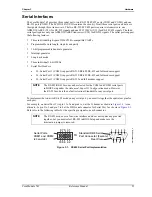
Chapter 3
Hardware
34
Reference Manual
CoreModule 745
Watchdog Timer
The Watchdog Timer (WDT) restarts the system if a mishap occurs, ensuring proper start-up after the
interruption. Possible problems include failure to boot properly, the application software’s loss of control,
failure of an interface device, unexpected conditions on the bus, or other hardware or software malfunctions.
The WDT (Watchdog Timer) can be used both during the boot process and during normal system operation.
•
During the Boot process – If the operating system fails to boot in the time interval set in the BIOS, the
system will reset.
Enable the WDT using
Boot Settings Configuration
of the Boot menu in BIOS Setup. Set the WDT for
a time-out interval in seconds, between 1 and 255, in one-second increments in the Boot Setting
Configuration screen. Ensure you allow enough time for the boot process to complete and for the OS to
boot. The OS or application must tickle the WDT as soon as it comes up. This can be done by accessing
the hardware directly or through a BIOS call.
•
During System Operation – An application can set up the WDT hardware through a BIOS call, or by
accessing the hardware directly. Some ADLINK Board Support Packages provide an API interface to
the WDT. The application must tickle the WDT in the time set when the WDT is initialized or the
system will be reset. You can use a BIOS call to tickle the WDT or access the hardware directly.
The BIOS implements interrupt 15 function 0C3h to manipulate the WDT.
•
Watchdog Code examples – ADLINK has provided source code examples on the CoreModule 745
Support Software QuickDrive illustrating how to control the WDT. The code examples can be easily
copied to your development environment to compile and test the examples, or make any desired
changes before compiling. Refer to the WDT Readme file on the CoreModule 745 Support Software
QuickDrive.
















































